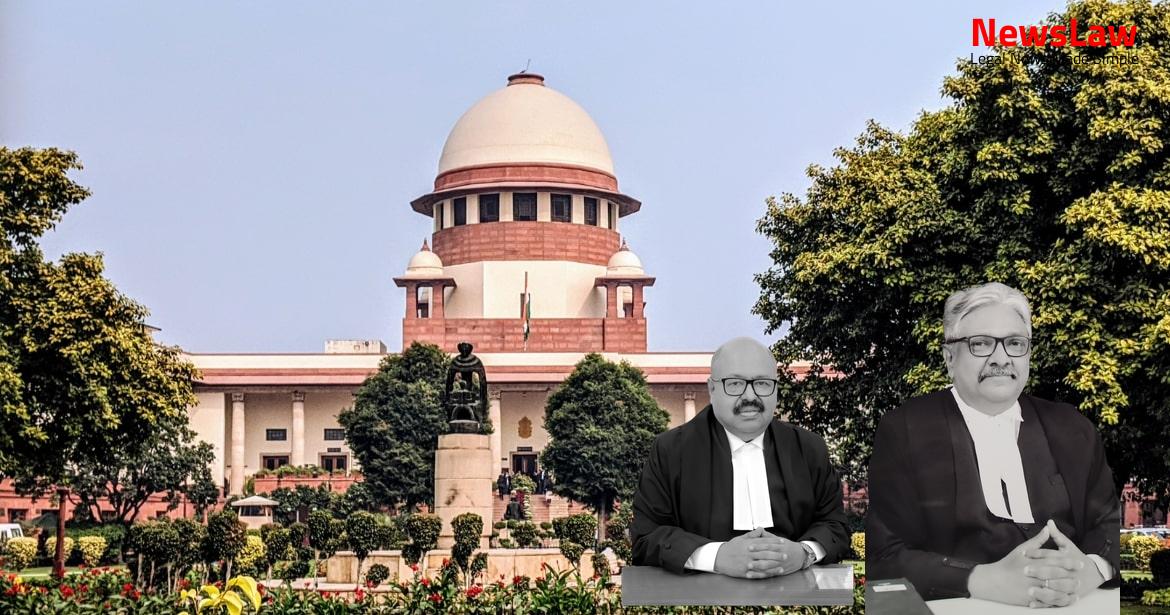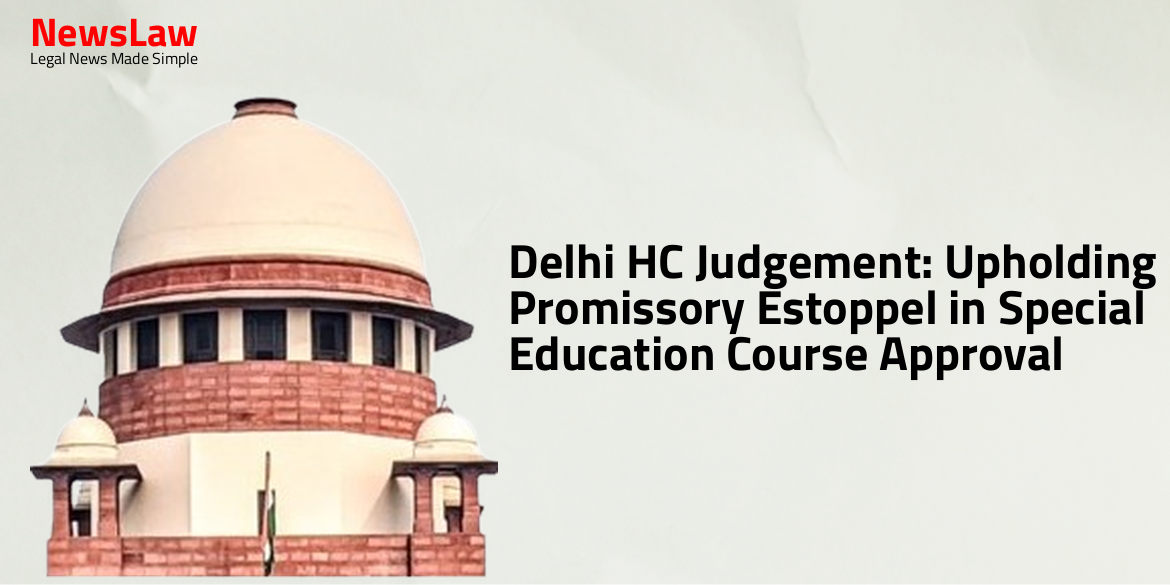Delve into a significant legal case where the Supreme Court analyzed the proviso in Rule 266(3) in the context of teacher recruitment. The case involved intricate legal arguments and interpretations regarding the eligibility criteria for candidates. Explore the details of this case and the implications of the court’s decision on the education sector. Stay informed about the legal intricacies surrounding this matter!
Facts
- High Court directed results to be declared for B.S.T.C. Course
- Appellant filed counter affidavit as respondent’s name was missing from select list
- Writ petition filed to quash final select list and appoint respondent
- Applicant must have educational qualifications by application submission date
- Result of respondent and another not uploaded, leading to writ petition
- Single Judge dismissed writ petition, leading to verification process
- Appellant discovered respondent did not have B.S.T.C. qualification
- Interim order passed to bring respondent’s result in sealed cover
- Appellant issued advertisement for teacher recruitment
- Respondent appeared based on High Court order, completed B.S.T.C. course
- Respondent’s writ appeals were allowed, securing 158.41 marks
- The amendment to sub-Rule (3) regarding academic qualifications was necessitated by subsequent legislation.
- Petitioners were entitled to benefits of employment based on merit except for back wages.
- Even after the amendment, it was found that the academic qualifications in clause (3) of Rule 266 were not expanded or qualified by the proviso.
- The High Court reasoned that sometimes a proviso may be unrelated to the preceding section and should be treated as a substantive provision dealing independently with the matter it contains.
- The High Court erred in holding that the proviso survived the substitution because it was an independent provision unrelated to the change in qualifications brought about by the amended Rule 266.
- The proviso dealt with a different area, specifically the time in which eligibility prescribed under the Rules had to be attained, and thus continued to hold the field.
Also Read: Judgment on Inconsistencies in Eyewitness Testimonies: Resham Singh v. State of India
Issue
- Controversy: Whether the High Court was correct in holding that the proviso to Rule 266(3) of the Rajasthan Panchayati Raj Rules remained valid despite the substitution of Rule 266(3) by a Notification.
- Issue to be resolved: Interpretation of the impact of the substitution of Rule 266(3) on the proviso in question.
- Key Point: Determining the legal effect of the substitution on the applicability and relevance of the proviso.
- Central Question: Whether the proviso to Rule 266(3) continues to stand after the substitution, as argued by the parties involved.
- Evaluation of Legal Provisions: Analysis of Rule 266(3) and the proviso in light of the relevant legal framework and precedents.
- Significance of High Court’s Interpretation: Assessing the reasoning and conclusion reached by the High Court in this matter.
Also Read: Judgment Summary: VSS Applications Fraud Allegations Case
Arguments
- The qualifications for appointment as teachers were amenable to changes based on the qualifications stipulated by the competent authority.
- The amendment dated 11.5.2011 introduced a new set of qualifications in sub-rule (3) of Rule 266.
- The respondent did not challenge the advertisement which specified the qualifications required.
- The advertisement mentioned that candidates must possess qualifications by the last application date.
- The High Court’s judgment was supported by the learned senior counsel for the respondent.
- The proviso in the rule was not continued when clause (3) of Rule 266 was substituted by the amendment.
- The amendment dated 5.10.2011 removed the proviso and placed the emphasis on the last date for determining qualifications.
- The advertisement dated 11.8.2013 was issued after the substitution in Rule 266, making the proviso no longer applicable.
- The proviso aimed to allow more candidates to participate by relaxing the qualification criteria.
- The provisions in an advertisement conflicting with statutory rules must be disregarded.
- The circular dated 29.2.2012 led to the replacement of a clause in the advertisement with the proviso to consider qualifications as of the last date mentioned.
Also Read: Case Summary: The Unveiling of Justice
Analysis
- The proviso in question determines the eligibility for the post of primary and upper primary school teacher based on the educational qualifications of the candidate.
- The respondent had appeared in the B.S.T.C. examination but had not passed it by the last date for filing the application.
- The respondent claimed eligibility by relying on the proviso, which allowed candidates who had appeared in the exam to apply, provided they submit proof of qualification before the declaration of results.
- The High Court considered the purpose of a proviso in interpreting the eligibility criteria.
- The availability of the proviso was crucial in determining the respondent’s eligibility for the teaching position.
- The proviso was first introduced on 1.7.2004 in Rule 266 (3) with variations.
- Subsequent amendments in 2006 and 2011 led to the proviso being repealed and not resurrected.
- The proviso was not saved during the substitution of Rule 266 (3) in 2006 or 2011.
- The legislative intent was clear that the entirety of Rule 266 (3), including the proviso, would be replaced by new provisions.
- The proviso, initially beneficial, did not reappear in the rules after 2011 amendments.
- The circular dated 29.2.2012 did not apply as the proviso ceased to exist legally after 2011.
- The changes in qualifications and the proviso were intricately linked to NCTE stipulations.
- The authorities understood that the proviso did not cease to exist during amendments.
- The process of a substitution of a statutory provision involves two steps: first, the old rule ceases to exist, and then the new rule is brought into existence
- When a statute is repealed without a saving clause, it destroys the effectiveness of the repealed act in the future and divests the right to proceed under it
- Outright repeal results in the destruction of the effectiveness of the repealed act in the future and may affect inchoate rights dependent on it
- There is an exception that repealed statutes still exist in respect of transactions that are past and closed
- Substitution of a provision leads to the repeal of the earlier provision and its replacement by the new provision
- Repeal of a statute does not affect its previous operation during the period it was in force
- The initial substitution of clause (3) of Rule 266 led to the repeal of all its provisions and the birth of a new provision in its place
- The Circular dated 29.2.2012 cannot be used in a case where the requirement was clearly specified in a later advertisement dated 11.8.2013.
- The advertisement in question from 2013 must be considered separately, and the Circular from 2012 cannot be applied in this context.
- By substituting Rule 266(3) with a notification dated 11.5.2011, the proviso in question ceased to exist.
- Therefore, the advertisement from 2013 adhered to the statutory rules in place at that time.
- Ultimately, the appeal is to be allowed, emphasizing that candidates must possess the required qualifications on the last date mentioned in the advertisement.
Decision
- The appeal has been allowed
- The impugned judgment of the High Court in Writ Appeal No. DBCSAW NO. 667/2015 has been set aside
Case Title: THE STATE OF RAJASTHAN Vs. TRILOK RAM
Case Number: C.A. No.-007215-007215 / 2019



